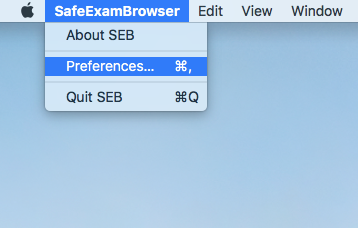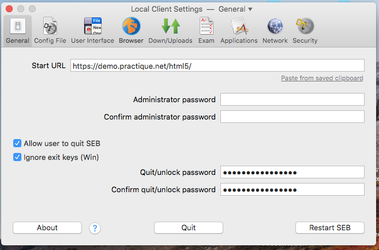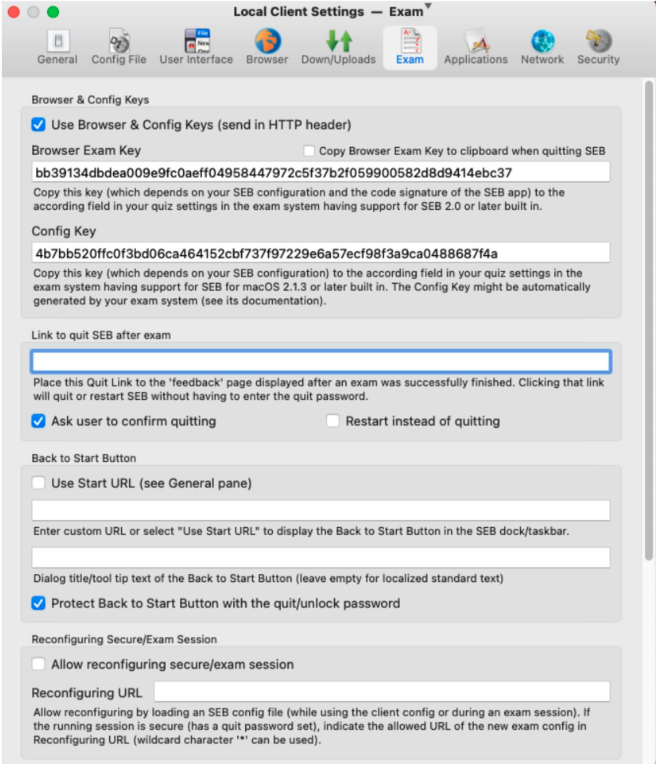Configuring Safe Exam Browser for Practique and BYOD
If you want to run written exams online and restrict the candidate's access to other applications using Practique you will need to configure Safe Exam Browser.
Safe Exam Browser is a third party browser designed specifically for online assessment. It allows exam systems like Practique to have control over the environment that the candidate has when taking the exam. For example, you might want to prevent candidates looking up something on another website or using any other application that may be on the desktop.
You will use a combination of Safe Exam Browser and a configuration file to set up the features you want. There are two main scenarios:
- Dedicated exam device - If you have one or a number of devices used for exams, you will probably set them up and not change their configuration very often. In these cases, every time Safe Exam Browser is started, it will default to the settings you have installed. Although we recommend setting up a configuration file, it is also possible to use Safe Exam Browser to set up a single device without a configuration file. We'll explain how in the instructions below.
- Bring Your Own Device (BYOD) - In this case, candidates will install Safe Exam Browser and receive your exam configuration file. Safe Exam Browser will only use those settings temporarily and default back to their original settings when it closes. This might be useful if candidates need to use the software for exams from different organisations.
The are a number of steps:
- Download Safe Exam Browser
- Create a configuration file
- Install or distribute the configuration file
- Starting the exam in Safe Exam Browser
Download Safe Exam Browser
- Download Safe Exam Browser from here. You will have the option to download either Windows, MacOS or iOS depending on your hardware.
- Follow the standard steps to install on your hardware.
- Once Safe Exam Browser has installed launch the application.
Create a configuration File
- To open Safe Exam Browser on MacOS, you will need to open 'Safe exam Browser" then click on Preferences. In Windows, select the Safe Exam Browser folder within Applications and then select 'SEB Configuration Tool'. Although there are some slight differences between the Windows and MacOS, they look generally the same. For more detailed information you should look at the user manuals for Windows and MacOS.
- Go to the "General" tab.
- In the "Start URL'" field you need to enter your own exam URL. This will be https://example.practique.net/html5/ Simply change the example to your own organisation.
- Safe Exam Browser can use up to 3 different password sections, 2 of which are set in the "General" tab:
- "Administrator" password. Setting this password keeps the configuration protected from unauthorised editing so should only be used by the person setting up Safe Exam Browser.
- "Quit/unlock" password. If set, it won't be possible for anyone to close or restart Safe Exam Browser without the password. This password is usually used by the Invigilator or exam administrator should they need to access the device's operating system while diagnosing problems or to unlock and close Safe Exam Browser at the end of an exam. You might not necessarily need a password if you feel that the environment the exam is being run in is secure enough.
- Go to the "Config File" tab
- "User SEB settings file for ...". By default, this is set to "configuring a client". That means that if the configuration file is run on a machine with Safe Exam Browser, Safe Exam Browser will be updated to always use these setting every time it is launched. Use this setting if you wish to use this on a dedicated device. If you only want to settings to be temporary, as may be the case for BYOD, change this setting to "starting an exam".
- "Settings Password". If you are intending on creating a settings file that will be stored or distributed, you might wish to create an password so it can't be read without authorisation. This password will be used each time the file is opened so will be needed by anyone who is installing the configuration on a dedicated device, or by candidates on their own devices. Alternatively, if you
- The settings we have described are only the minimum settings that you should edit. Safe Exam Browser gives you a great deal of control over what candidates can see and use during an exam, so we would encourage you to take the opportunity to look through and customise is to your own specific needs by checking the manuals for Windows and MacOS.
- Now we need to save the settings. Still within the "Config File" tab you have two options:
- If you ONLY want to set up the device you are currently working on, click the "Use Current Settings to ... Configure Client". In most cases, option b will apply.
- If you want to create a configuration file, select "Config File Editing ... Save Settings As", and then save the file to anywhere you can access later.
- Once you have completed the steps, close the application.
Install or distribute the configuration file
How you use the configuration file will depend on whether you are setting up dedicated devices or distributing the file to candidates to use on their own device.
Dedicated Device
If you set up a single device to "Use Current Settings to ... Configure Client", then there is nothing else to do - Safe Exam Browser has been set up with your settings.
However, if you created a configuration file, you will now need to run the configuration file on any machines you wish to set up.
- Make sure that Safe Exam Browser is installed on the device.
- Save the configuration file on the machine.
- Double click on the file to run it. if you added a settings password, you will be prompted to enter it.
- You will see a confirmation message saying that the configuration has been applied. You can either open Safe Exam Browser or quit.
- Each time the main Safe Exam Browser application is opened, it will now use the default settings you have created
Within managed environments, it is also possible to deploy the files directly devices which may you may find more efficient. For more information, please check the Safe Exam Browser user manual.
Bring Your Own Device (BYOD)
If you will asking candidates to use their own devices, you will need to give them instructions and inform them how to install the configuration file. Below are some example instructions which may need to be amended depending on how you have set up the configuration file.
Candidate instructions
In order to take the exam in a secure environment the each candidate will need to install Safe Exam browser and run an Exam configuration file (supplied by the exam provider). Practique can run on any device that has a modern browser, but does not support the lock down functionality for Android Tablets.
Candidates will need a device that:
- Supports a modern browser (Firefox, Chrome)
- Has sufficient battery life for the duration of the exam
- At a minimum has an internet connection to download and start the exam
- At a minimum has an internet connection to upload the exam responses at the end of the exam.
As a Candidate follow the steps below to set up your device and start the exam:
At least one week before the scheduled exam:
- Download Safe Exam Browser from by clicking on the link depending on which device you own. Windows PC or Laptop, Mac or iPad. Your download should start automatically. If it does not, follow the instructions to download Safe Exam Browser.
- When the download is complete follow the instructions to install on your device. You will only have to do this for your exams and you can delete the file once the exam is over.
On the day of the exam:
- Separately you will have received an exam configuration file from your assessment provider.
- When instructed open this file. If necessary, it may also be necessary to enter a password which the assessment provide will give you. You will be taken to your exam (You will need to be connected to the internet for this to work)
- Candidates will login to the exam as instructed by the invigilator or exam administrator.
- Candidates will not be able to exit Practique, perform any other actions than permitted by Safe exam Browser or exit Safe Exam Browser.
- In order to exit the exam and Safe exam Browser you can click "Quit SEB" in the top righthand corner. Candidates will need the Quit passcode to exit and this will be provided by the invigilator or exam administrator at the end of the exam.
Starting the Exam in Safe Exam Browser
- For dedicated devices, every time you launch Safe Exam Browser, it will navigate to the available exams that you have published to Practique for Browser (P4B). In the case of BYOD, clicking the file will open Safe Exam Browser with the settings you have provided.
- Candidates will login as normal, but will not be able to exit Practique, or perform any other actions other than those permitted by Safe exam Browser.
- Once the exam is finished, you should ensure that the candidate has logged out of P4B. To shut down Safe Exam Browser, it might be necessary for the candidates to enter the quit passcode, as described above in the candidate instructions. For dedicated devices, it really depends on your set up, as you may wish to leave Safe Exam Browser running. Otherwise, the quit password will need to be entered if you have created one.
Checking Safe Exam Browser Settings (BYOD)
To ensure that SEB is correctly configured and secured, it is possible to check that the candidate is using the correct SEB settings. This is achieved by using header keys that get SEB to send additional information with candidate responses which Practique can then validate.
A Header Key is an alphanumeric code used to verify which version of Safe Exam Browser is being used by a candidate. These codes can be added to an exam configuration depending on the required outcome.
Header keys usage:
- SEB with no listed keys - This is the simplest version that checks that SEB is being used during an exam but has the disadvantage that the candidate may not be using the correct settings.
- SEB with Configuration Keys (CK) - To check that SEB is being used with the correct configuration. More complex but also more secure.
- SEB with Browser Exam Keys (BEK) - To check that a specific version of SEB is being used with the correct configuration. The most effort, because a key is required for each version of SEB on each operating system. This might be useful if there is a known issue with a specific version of SEB.
It is possible to use SEB without any key checks. For example, if you are using an exam suite where all exam devices are centrally managed. The options chosen will depend on the specific requirements of your college and staff: balancing security, effort (of the exam administrators and candidates) and risk of human error in set up.
Once a SEB configuration file has been created, it is possible to reuse the same configuration file and keys for any future exams in order to reduce administration time. The key will still need to be added to each exam.
Configuration:
Once SEB has been configured as required, go to Settings, then Exam then ensure to check the box Use Browser & Config Keys. The Browser Exam Key (BEK) and Config Key (CK) should be copied at this point. These keys change every time that the configuration file is changed and saved.
The CK will be the same across all versions of SEB and operating systems, but the BEK will be unique for each version and OS. Even if specific config or browser keys won’t be checked, the setting to use keys will still be required if Practique is to check that SEB is being used.
Practique exam settings:
When creating an Exam the Require Safe Exam Browser option needs to be set to Yes, this is located in the initial Exam Settings Page. This will display the SEB Configuration Key list (CK) and SEB Browser Exam Key list (BEK) fields. Depending on the required setup, either no, or several, keys will need to be entered into these boxes. Each key should be entered on its own line.

During an exam:
During an Exam responses received by Practique will be checked for the presence of the SEB Header Keys. If Practique determines that a response is missing a required header or the header is incorrect, it will mark the candidate's response as invalid with the warning Failed: SEB Check. The responses will then need to be rejected or accepted as appropriate by the exam administrator. Details of the response can be seen using the ‘Toggle details’ link below the error.

For security reasons, the SEB Header Key will not match the CK or the BEK entered in the Edit Exam Details screen. Practique uses the Header Key and the exam address to generate the expected header and compares it to the Header Key that SEB sends to the candidate. Response Header Keys will also be unique to each candidate.
Related articles
-
Page:
-
Page:
-
Page:
-
Page:
-
Page:



Default settings

Suggested Exam settings

